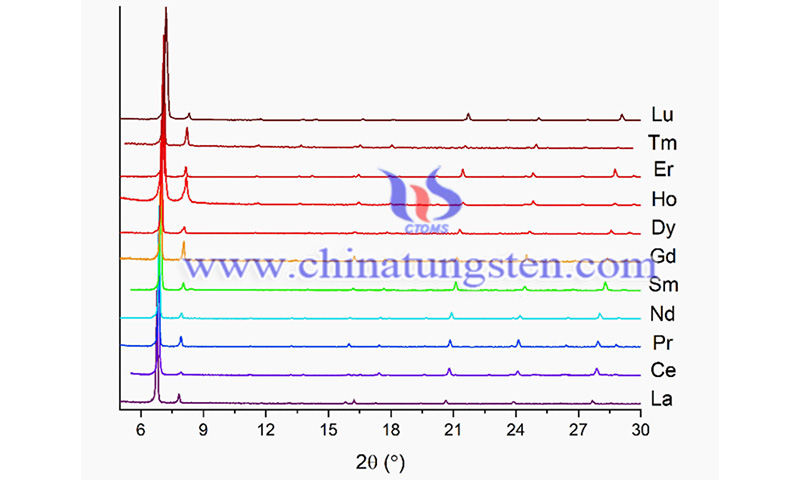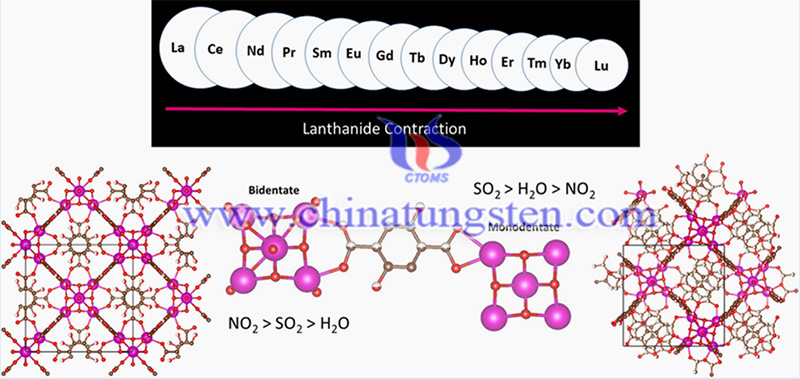Rare Earth Elements to Address Acid Gas Pollution
- Details
- Category: Tungsten's News
- Published on Wednesday, 25 May 2022 19:12
Materials made from rare earth elements (REEs) may hold the key to addressing pollution caused by acid gas nitrogen dioxide (NO2) and sulfur dioxide (SO2). Researchers at Oak Ridge National Laboratory, Sandia National Laboratory, and the University of Tennessee, Knoxville, use REEs based metal-organic frameworks (MOFs) to efficiently detect and trap acidic gases.
In a paper titled: “Kinetically Controlled Linker Binding in Rare Earth-2,5-Dihydroxyterepthalic Acid Metal–Organic Frameworks and Its Predicted Effects on Acid Gas Adsorption” published in ACS Applied Materials and Interfaces, the scientists explain that the approach includes various technical solutions designed to filter the air by capturing or capturing toxic emissions, and in some cases, the captured molecules can also be stored and reused.

(Source: Susan E. Henkelis/ACS Appl. Mater. Interfaces)
MOFs are essentially microscopic matrices of metal atoms that are interconnected by organic molecules to form repeating patterns of tiny, interconnected metal cages. They act like a sponge that adheres or absorbs molecules to its surface.
The researchers used a combination of computer simulations as well as neutron and X-ray scattering experiments to help them determine the best conditions for synthesizing these materials. In the process, they also uncovered important details about an interesting defect that forms in MOFs that they say could be useful in building devices that capture emissions or sense dangerous levels of toxic gases.
"The metal-organic framework is really novel in terms of its flexibility, its chemistry and how it can tailor its structure." Susan Henkelis, lead author of the study, said in a media statement, "If you swap out the organic molecules, you can adjust the structure to target different gases. Acid gas typically comes from combustion processes, so this research could be useful in developing devices to help limit emissions from large-scale industrial facilities such as oil refineries and fossil fuel-based power plants."
According to Henkelis and her colleagues, the first step in the study was to understand how the atomic bonds in MOFs are formed and how the atoms are arranged.

(Source: Susan E. Henkelis/ACS Appl. Mater. Interfaces)
Ideally, the cage inside each synthesized MOF forms a cube. Each corner contains a cluster of six rare earth elements ions, with another cluster at the center of the cube. Each pair of metal ions in the cluster is connected to another pair of metal ions in another cluster by a linkage or linking molecule.
However, defects sometimes occur, especially in MOFs made from europium ions, where the connections kink and expose rare earth ions, which increases the likelihood of contaminant molecules being trapped in the structure.
To find out why this happens, the researchers used a combination of neutron and X-ray scattering experiments to map the atomic structure of the material.
They used X-rays to find heavy metal elements, which provided an outline of the overall structure. And, to better understand how organic molecules are arranged, they bombarded the materials with an instrument called a Spallation Neutron Source (SNS), which helped them track the positions of hydrogen, carbon and oxygen atoms that form molecular bonds between clusters of metal ions.
From the experiments, the team was able to determine that materials with defects actually formed faster than their defect-free counterparts. They also found that defects could be induced by adjusting the temperature and the time required to grow the crystalline material.
The team then performed computer simulations using structural data obtained from the experiments to see how each material-defective and defect-free structures-interacted with NO2 and SO2.
“Although this is a basic study, using rare earth elements to address acid gas pollution could have a big impact in the future," said Tina Nenoff, corresponding author of the study. We can control and design MOFs with more specificity in light of this research, and in the meantime, we have developed an integrated approach to evaluating large series of MOFs that will help accelerate the search for new candidate materials and their development."
- Rare Earth Manufacturer & Supplier, Chinatungsten Online: www.chinatungsten.com
- Tungsten News & Prices of China Tungsten Industry Association: www.ctia.com.cn
- Molybdenum News & Price: news.molybdenum.com.cn
- Tel.: 86 592 5129696; Fax: 86 592 5129797; Email: sales@chinatungsten.com



 sales@chinatungsten.com
sales@chinatungsten.com